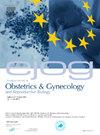一例罕见的巨大胎盘绒毛膜血管瘤导致多胎妊娠和胎儿水肿:病例报告和文献综述
IF 2.1
4区 医学
Q2 OBSTETRICS & GYNECOLOGY
European journal of obstetrics, gynecology, and reproductive biology
Pub Date : 2025-02-11
DOI:10.1016/j.ejogrb.2025.02.024
引用次数: 0
摘要
本文章由计算机程序翻译,如有差异,请以英文原文为准。
A rare case of giant placental chorioangioma causing polyhydramnios and fetal hydrops: A case report and literature review
Background
Placental chorioangioma is a benign tumour of the placenta. In most cases, chorioangiomas are small and do not result in maternal or fetal complications. This report presents a case with a large placental chorioangioma, which was associated with an intrapartum event leading to significant maternal and perinatal morbidity.
Case presentation
A case of placental chorioangioma was diagnosed at 29 + 1 weeks of gestation. As the tumour enlarged progressively with polyhydramnios, further ultrasound examination indicated signs of fetal hydrops. Following multi-disciplinary team discussion, caesarean section was performed with delivery of a female infant. Pathological examination of the placenta confirmed an infarcted chorioangioma.
Conclusions
Placental chorioangiomas are benign, non-trophoblastic vascular neoplasms. While often asymptomatic, they can occasionally have unfavourable outcomes. Ultrasound examination plays a critical role in their diagnosis and monitoring. These neoplasms exhibit a wide range of clinical manifestations, leading to their classification as a spectrum of symptoms rather than a distinct syndrome. Early diagnosis, vigilant prenatal surveillance, and timely intervention are essential to minimize fetal morbidity and mortality.
求助全文
通过发布文献求助,成功后即可免费获取论文全文。
去求助
来源期刊
CiteScore
4.60
自引率
3.80%
发文量
898
审稿时长
8.3 weeks
期刊介绍:
The European Journal of Obstetrics & Gynecology and Reproductive Biology is the leading general clinical journal covering the continent. It publishes peer reviewed original research articles, as well as a wide range of news, book reviews, biographical, historical and educational articles and a lively correspondence section. Fields covered include obstetrics, prenatal diagnosis, maternal-fetal medicine, perinatology, general gynecology, gynecologic oncology, uro-gynecology, reproductive medicine, infertility, reproductive endocrinology, sexual medicine and reproductive ethics. The European Journal of Obstetrics & Gynecology and Reproductive Biology provides a forum for scientific and clinical professional communication in obstetrics and gynecology throughout Europe and the world.

 求助内容:
求助内容: 应助结果提醒方式:
应助结果提醒方式:


